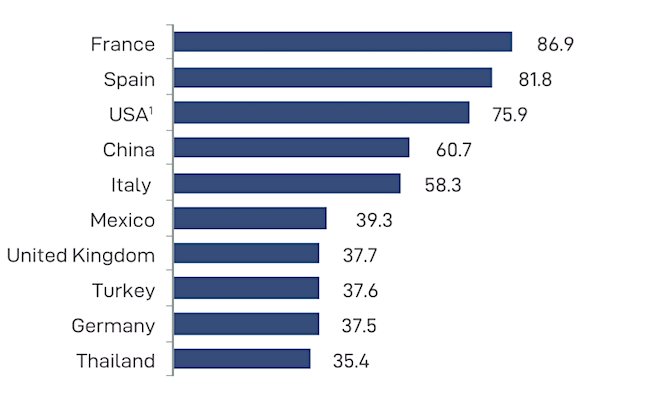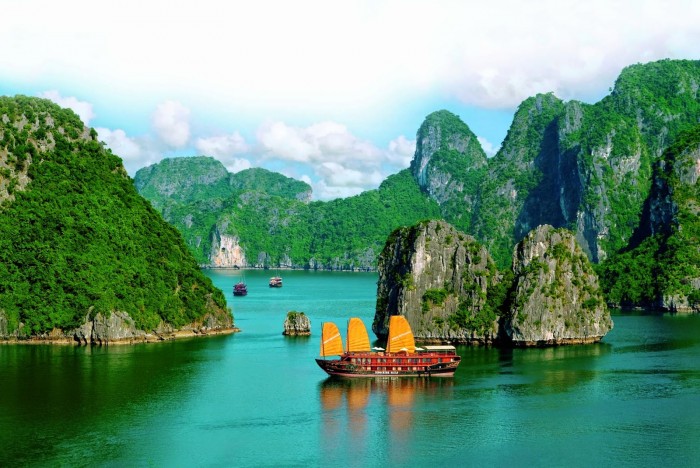Vietnam turns semiconductor vision into action
The global semiconductor industry is being reshaped by geopolitical tensions, shifting supply chains, and the surge of digital technologies.




Thailand has more than 50 million residents but welcomes 35.4 million foreign visitors while Vietnam can only attain half as much as that figure despite nearly doubling in population.
At the International Real Estate Conference 2018 on "Vietnam: the World of Opportunities", Doan Van Binh, vice president of Vietnam Real Estate Association cum CEO Group's chairman, expressed his aspiration for Vietnam to become a new tourism power in the world, which may contribute $100 billion to GDP.
Tourism in Vietnam has been developing by leaps and bounds in recent years. After successfully attracting 10 million foreign visitors in 2016, Vietnam welcomed nearly 13 million more in 2017, catching up with Indonesia for the first time. Also, this figure was only slightly fewer than Singapore’s foreign tourist arrivals - 17.4 million.
Also in 2017, Vietnam served over 73 million domestic tourists. For the first time, Vietnam made it at the sixth rank in the list of countries with the fastest tourism growth in the world, also the highest rank of an Asian country here.
Breakthroughs in recent years have laid the basis for expectation to outperform the aims by 2020 and making Vietnam a new tourism power.

We have enough opportunities and abilities to realise this expectation.
At present, the government is regarding agriculture, tourism, and information technology as three key economic sectors. However, if you compare the current state, international competitiveness or potential in the flat world, tourism is the most feasible to compete with the leading non-smoke industries in ASEAN, Asia and over the world.
With the advantages of natural, cultural, and historical conditions, Vietnam can definitely catch up with Thailand if the economy has breakthroughs. Robots cannot replace heartfelt smiles even in the 4.0 industrial revolution.
In the Tourism Competitiveness Index of World Economic Forum, Vietnam ranks high on natural, cultural and human resources as well as national security and cost competitiveness. Vietnamese businesses that have been able to develop satisfying tourism projects are increasing.
According to statistics of Vietnam National Administration of Tourism in 2017, the total number of three to five-star hotel rooms in Vietnam is about 100,000. The high-quality lodging industry is now booming. In particular, CBRE real estate consultancy firm predicted that the number of hotel rooms in four key markets: Da Nang, Nha Trang, Ha Long and Phu Quoc would increase to 84,300 rooms by 2020.
Private businesses have taken the lead in developing new tourism products and large entertainment complexes. They have also participated in airport construction and aircraft procurement to expand the flight network from international markets to Vietnam as well as between key domestic tourism markets.
However, Vietnam’s tourism is still lagging behind many countries in the region. For example, it still lacks products that can make up an exclusive destination like Singapore Marina Bay Sands, Disneyland or Universal-themed parks. The factors motivating the development of Vietnam’s tourism such as infrastructure, priority or openness are all ranked low by the World Economic Forum.
To accelerate the growth of Vietnam’s tourism, the State needs to eliminate four giant bottlenecks as follows.
First, the infrastructure should be completed. Decent infrastructure will connect and promote local tourism. Airport systems in key tourism markets need further investment and upgrade to meet the growing demand. Thankfully, private resources have recently been attracted to build terminals and airports in Van Don, Da Nang and Cam Ranh. However, the infrastructure and services of many other airports still cannot keep pace with the current growth of tourism.
One of the problems of transport infrastructure is the outdated one-metre railway system. Roads have been greatly improved, for example, the Ha Noi - Hai Phong - Ha Long - Van Don Expressway to be completed by the end of this year, which will shorten the travel time from Ha Noi to Ha Long and Van Don, thereby facilitating breakthroughs for tourism there. However, travelling to many other potential destinations is still strenuous, as it takes 10 hours to travel all the way from Hanoi to Quang Binh, or six hours from Ho Chi Minh City to Rach Gia. Without decent transport infrastructure, the Mekong Delta is unlikely to develop rapidly.
To catch up with regional and global neighbours, we need a high-speed North-South rail along with a modern aviation network. Why don’t we pilot the Shinkansen high-speed model on the routes of Nha Trang – Ho Chi Minh City or Hanoi – Vinh?
Second, visa-exemption policies for foreign visitors to Vietnam should be expanded as soon as possible to help them save time and cost, hence promoting the attractiveness of Vietnam tourism. In practice, countries that can attract more than 20 million visitors each year have a very open visa-exemption policy.
Recently, Vietnam has implemented the policy of granting electronic visas and granting visas at the border gates to simplify the procedures for foreign visitors. Also, the visa policy is more open when Vietnam exempts visas for visitors from 24 countries. However, compared to other countries in the region, Vietnam is still considered rigorous as Thailand exempts visas for citizens of 57 countries, Indonesia - 168 countries, Malaysia - 162 countries and Singapore - 159 countries.
Being shy means not being able to welcome our guests with all our heart. Tourism is a key sector in attracting foreign profits, so why don’t we open the door? Considering efficiency, each visitor has to spend $25 on visa fees and an average Australian visitor spends about $1,500 in Vietnam. These figures can speak.
Phu Quoc is a shining example of the benefits of the 30-day visa exemption policy. In 2017, there were dozens of international flights to Phu Quoc each day, contributing about 30 per cent of international visitors, especially those took direct flights from Western Europe. These tourists usually stayed for at least 15 days and spent about $1,500 - $2,000 per person during the stay.

Third, human resources should be improved. The State should attract investment in training an abundant and skilled workforce for the booming tourism industry. One to two per cent of the total revenue from tourism should be spent on this purpose.
Fourth, the State and the entire society should join hands in tourism promotion. Currently, the budget for this activity is less than $2 million each year, while Malaysia spends $69 million, Singapore - $80 million, Thailand $105 million.
Amateur promotion and lack of research have resulted in less competitiveness of Vietnam’s tourism compared to other countries in the region. Only 1-2 per cent of total tourism revenue spent on promotion will make remarkable changes. Also, enterprises can also help by participating in international fairs and exhibitions as well as cooperating with worldwide famous brands of hotel managers and travel agencies.
With decent infrastructure, sufficent and skilled human resources, efficient promotion, as well as the support of enterprises in developing tourism products, Vietnam can completely become a dynamic tourism hub of the world, gaining hundreds of billions of dollars for GDP in the future.
*The article reflects the views of author Doan Van Binh, vice president of Vietnam Real Estate Association cum CEO Group's chairman.
The global semiconductor industry is being reshaped by geopolitical tensions, shifting supply chains, and the surge of digital technologies.
The change in APA approval authority is expected to shorten processing time and enhance business proactiveness in international tax negotiations.
As hybrid cloud systems grow more complex, Vietnamese enterprises are struggling to detect cybersecurity threats moving laterally within their own networks.
The submission of the draft resolution on Vietnam’s international financial center to the National Assembly heralds a new developmental era for the country.
More than just running a 5-star resort, Kristian Petersen is redefining the art of hospitality with a humane and sustainable leadership philosophy.
For Tyna Huynh, co-founder of Drinkizz, organic is not just a food choice but a way of life that fosters a deep connection between people, nature and community.